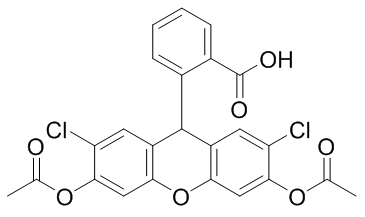All AbMole products are for research use only, cannot be used for human consumption.

H2DCFDA is a cell-permeable probe used to detect intracellular reactive oxygen species (ROS) (Ex/Em=488/525 nm). H2DCFDA can be used for the Bacterial reactive oxygen species (ROS) production assay.
ROS Measurements
For the detection of intracellular ROS level ,ROS-sensitive probe H2DCFDA is used. Adherent cells (ESCs, difESCs, eMSCs, HeLa, U118) are incubated with 5 µM staining solution in PBS in the dark for 30 min at 37°C, then harvested with 0.05% trypsin-EDTA solution, suspended in a fresh medium, and immediately analyzed with flow cytometer. Lymphocytes, both control and PHA-activated, are resuspended in PBS, incubated with 5 µM of H2DCFDA in the dark for 30 min at 37°C, and immediately analyzed. Along with the H2DCFDA probe, if indicated, ROS-insensitive modification of the fluorescent dye DCFDA is used. The staining procedure is the same as for the H2DCFDA.

J Colloid Interface Sci. 2025 Jun 22; .
Excipient-free self-assembled nanotheranostics enable synchronous sensitization of tumoricidal photothermal and photodynamic therapies through mitochondrial …
H2DCFDA purchased from AbMole

Mater Today Bio. 2025 Feb 03.
Nature-derived microneedles with metal-polyphenolic networks encapsulation for chronic soft tissue defects repair: Responding and remodeling the regenerative microenvironment
H2DCFDA purchased from AbMole

Plant Sci. 2025 Jun 27; .
A pectin methylesterase inhibitor NtPMEI21 negatively regulates resistance to brown spot disease in Nicotiana tabacum L.
H2DCFDA purchased from AbMole

Science Advances. 2024 Aug 16;10(33):eado7249.
Magnetically attracting hydrogel reshapes iron metabolism for tissue repair
H2DCFDA purchased from AbMole

J Colloid Interface Sci. 2024 Jun;663:810-824..
Amino acid-based metallo-supramolecular nanoassemblies capable of regulating cellular redox homeostasis for tumoricidal chemo-/photo-/catalytic combination therapy
H2DCFDA purchased from AbMole

GeroScience. 2024 Dec 27.
Paroxetine promotes longevity via ser-7-dop-4-IIS axis in Caenorhabditis elegans
H2DCFDA purchased from AbMole

Int Immunopharmacol. 2024 Sep 12;142(Pt A):113041.
Salidroside alleviates ferroptosis in FAC-induced Age-related macular degeneration models by activating Nrf2/SLC7A11/GPX4 axis
H2DCFDA purchased from AbMole

Foods. 2024 Dec 14.
Chemometric Classification and Bioactivity Correlation of Black Instant Coffee and Coffee Bean Extract by Chlorogenic Acid Profiling
H2DCFDA purchased from AbMole

Plant Biotechnol J. 2023 May;21(5):943-960.
The C2H2-type zinc finger transcription factor OSIC1 positively regulates stomatal closure under osmotic stress in poplar
H2DCFDA purchased from AbMole

Materials Today Bio. 2023 Jun 19.
Melanin inspired microcapsules delivering immune metabolites for hepatic fibrosis management
H2DCFDA purchased from AbMole

J Agric Food Chem. 2023 Nov 22;71(46):18059-18073.
Transcriptome Analysis of GmPUB20A Overexpressing and RNA-Interferencing Transgenic Hairy Roots Reveals Underlying Negative Role in Soybean Resistance to Cyst Nematode
H2DCFDA purchased from AbMole

Int Immunopharmacol. 2023 Sep 21;124(Pt B):110963.
BNTA attenuates temporomandibular joint osteoarthritis progression by directly targeting ALDH3A1: An in vivo and in vitro study
H2DCFDA purchased from AbMole

Burns Trauma. 2023 Oct 31;11:tkad030.
S100 calcium-binding protein A9 promotes skin regeneration through toll-like receptor 4 during tissue expansion
H2DCFDA purchased from AbMole

Environ Toxicol. 2023 Jul 29.
Wogonin alleviates BaP-induced DNA damage and oxidative stress in human airway epithelial cells by dual inhibiting CYP1A1 activity and expression
H2DCFDA purchased from AbMole

Biochem Biophys Res Commun. 2023 Oct 5;682:163-173.
Experimental and theoretical studies on inhibition against tyrosinase activity and melanin biosynthesis by antioxidant ergothioneine
H2DCFDA purchased from AbMole

J Cosmet Dermatol. 2023 Jul 10.
Potent pigmentation inhibitory activity of incensole‐enriched frankincense volatile oil‐identification, efficacy and mechanism
H2DCFDA purchased from AbMole

Stem Cell Rev Rep. 2022 Aug;18(6):2088-2103.
Human Umbilical Cord-Derived Mesenchymal Stem Cells Ameliorate Skin Aging of Nude Mice Through Autophagy-Mediated Anti-Senescent Mechanism
H2DCFDA purchased from AbMole

Parasit Vectors. 2022 Aug 1;15(1):274.
Neospora caninum infection induced mitochondrial dysfunction in caprine endometrial epithelial cells via downregulating SIRT1
H2DCFDA purchased from AbMole

Comp Biochem Physiol C Toxicol Pharmacol. 2021 Apr;242:108938.
Clove essential oil confers antioxidant activity and lifespan extension in C. elegans via the DAF-16/FOXO transcription factor
H2DCFDA purchased from AbMole

Ren Fail. 2021 Dec;43(1):900-910.
MMP-9-mediated regulation of hypoxia-reperfusion injury-related neutrophil inflammation in an in vitro proximal tubular cell model
H2DCFDA purchased from AbMole

Mediators Inflamm. 2020 Jun 6;2020:4321912.
CD137 Signaling Promotes Endothelial Apoptosis by Inhibiting Nrf2 Pathway, and Upregulating NF- κ B Pathway
H2DCFDA purchased from AbMole

Anat Rec (Hoboken). 2020 Jan 21.
Resibufogenin inhibited colorectal cancer cell growth and tumorigenesis through triggering ferroptosis and ROS production mediated by GPX4 inactivation
H2DCFDA purchased from AbMole
| Molecular Weight | 487.29 |
| Formula | C24H16Cl2O7 |
| CAS Number | 4091-99-0 |
| Solubility (25°C) | DMSO: ≥ 90 mg/mL |
| Storage | -20°C, protect from light |
[1] Karyne Rangel, et al. Microorganisms. Detrimental Effect of Ozone on Pathogenic Bacteria
| Related Fluorescent Dye Products |
|---|
| pH Fluorescent Probe Red 600, SE
pH Fluorescent Probe Red 600, SE is a pH-sensitive fluorescent dye, the fluorescence intensity changes significantly with changes in the pH of the environment. pH Fluorescent Probe Red 600, SE is weakly fluorescent outside the cells, but its fluorescence is significantly enhanced in acidic compartments (such as phagosomes, lysosomes and endosomes). It can be used for multiplexing cellular functional analysis with green dyes such as GFP, Fluo-8, calcein, or FITC-labeled antibodies. Ex (nm) 576, Em (nm) 597 |
| DSPE-Rhodamine
DSPE-Rhodamine is formed by the conjugation of DSPE with the Rhodamine fluorescent dye. DSPE possesses a hydrophobic lipid tail and a hydrophilic head group, while Rhodamine is a red fluorescent dye. DSPE-Rhodamine retains the lipid properties of DSPE while also imparting fluorescent labelling capabilities. As a key component of delivery systems, DSPE-Rhodamine enhances targeting and bioavailability. Its lipid properties facilitate the penetration of molecules through cell membranes, while its fluorescent properties enable tracking of distribution and dynamic changes within the body. |
| LD540
LD540 is a novel high-sensitivity lipophilic dye modified with BODIPY fluorescent groups, designed for precise labelling and imaging of lipid droplets. LD540 exhibits excellent photostability and an optimal fluorescence spectrum, making it compatible with various commonly used fluorescent dyes (such as DAPI and Alexa Fluor 647), thereby supporting multi-colour imaging requirements. Additionally, LD540 is suitable for both fixed and live cells and can label ultra-small lipid droplets. |
| PDMPO
PDMPO (Yellow/Blue DND-160) is a ratiometric probe for the determination of lysosomal pH for fluorescence imaging. PDMPO exhibits pH-dependent dual excitation and dual emission peaks. PDMPO produces blue fluorescence (Ex/Em=329 nm/440 nm) in weakly acidic organelles, and in more acidic lysosomes it becomes yellow fluorescence (Ex/Em=384 nm/540 nm). |
| Copper probe CF4
Copper probe CF4 (Copper fluor CF4) is a Cu+-specific fluorescent probe based on a rhodol dye scaffold. Copper probe CF4 (Copper fluor CF4) has high copper selectivity with a Kd value of 2.9×10-13 M, particularly over zinc and iron, as well as abundant cellular alkali and alkaline earth metals. Copper probe CF4 (Copper fluor CF4) is stable in a physiologically relevant pH regime between 6 and 8 (wavelengths of 415 nm for excitation and 660 nm for emission). Copper probe CF4 (Copper fluor CF4) can be used to study colon cancer. |
All AbMole products are for research use only, cannot be used for human consumption or veterinary use. We do not provide products or services to individuals. Please comply with the intended use and do not use AbMole products for any other purpose.


Products are for research use only. Not for human use. We do not sell to patients.
© Copyright 2010-2024 AbMole BioScience. All Rights Reserved.
